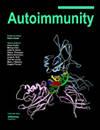间充质干细胞衍生的外泌体通过Nrf2/HO-1途径改善高糖和脂多糖诱导的HPMECs损伤
IF 3.1
4区 医学
Q3 IMMUNOLOGY
引用次数: 0
摘要
间充质干细胞衍生的外泌体(MSC-Exo)被认为在人类疾病的治疗中具有巨大的潜力。然而,MSC-Exo在糖尿病合并败血症过程中的作用及其潜在的分子机制尚不清楚。用高糖(HG)和脂多糖(LPS)处理人肺微血管内皮细胞(hpmes)。采用细胞计数试剂盒8法、transwell法和成管法分析细胞活力、迁移、血管生成。采用跨膜电阻(TER)检测和fitc -葡聚糖法评价细胞屏障功能。western bolt (WB)法检测细胞通透性相关标志物、嗜铁性相关标志物、外泌体相关标志物、Nrf2和HO-1蛋白水平。采用ELISA法检测各组炎症因子水平,采用相应试剂盒检测各组凋亡相关指标水平。采用流式细胞术分析干细胞标记物。采用透射电镜、纳米颗粒跟踪分析和WB分析对MSC-Exo进行鉴定。采用DIO染色检测hpmes对MSC-Exo的摄取。HG处理抑制hpmec的活力、迁移、血管生成和TER,促进通透性、炎症和铁下垂。LPS处理加重hg诱导的hpmec功能障碍、炎症和铁下垂。hmec与MSC-Exo共培养后,HG + LPS诱导的细胞损伤明显减轻。此外,MSC-Exo处理可增强HG + lps诱导的hpmes中Nrf2/HO-1通路的活性,Nrf2沉默的MSC-Exo可促进HG + lps诱导的hpmes损伤。MSC-Exo通过激活Nrf2/HO-1通路减轻HG + lps诱导的hpmec损伤,证实其可能用于糖尿病脓毒症的治疗。本文章由计算机程序翻译,如有差异,请以英文原文为准。
Mesenchymal stem cells-derived exosomes ameliorate high glucose and lipopolysaccharide-induced HPMECs injury through the Nrf2/HO-1 pathway
Abstract Mesenchymal stem cells-derived exosomes (MSC-Exo) are considered to have great potential in the treatment of human diseases. However, the role of MSC-Exo in the process of diabetes with sepsis and the underlying molecular mechanism remain unclear. Human pulmonary microvascular endothelial cells (HPMECs) were treated with high glucose (HG) and lipopolysaccharide (LPS). Cell viability, migration, angiogenesis were analyzed by cell counting kit 8 assay, transwell assay and tube formation assay. Transmembrane electrical resistance (TER) detection and FITC-dextran assay were performed to evaluate cell barrier function. The protein levels of cell permeability-related markers, ferroptosis-related markers, exosomes-related markers, Nrf2 and HO-1 were examined using western bolt (WB) analysis. Besides, the levels of inflammation factors were tested by ELISA, and the levels of ferroptosis-related indicators were examined using corresponding assay kits. Flow cytometry was employed to analyze stem cell markers. The identification of MSC-Exo was performed using transmission electron microscopy, nanoparticle tracking analysis and WB analysis. DIO staining was used to examine the uptake of MSC-Exo by HPMECs. HG treatment suppressed HPMECs viability, migration, angiogenesis and TER, while promoted permeability, inflammation and ferroptosis. LPS treatment aggravated HG-induced HPMECs dysfunction, inflammation and ferroptosis. After HPMECs were co-cultured with MSC-Exo, cell injury induced by HG + LPS could be relieved. Moreover, MSC-Exo treatment enhanced the activity of Nrf2/HO-1 pathway in HG + LPS-induced HPMECs, and Nrf2-silenced MSC-Exo could promote HG + LPS-induced HPMECs injury. MSC-Exo alleviated HG + LPS-induced HPMECs injury via activating Nrf2/HO-1 pathway, confirming that it might be used for the treatment of diabetes with sepsis.
求助全文
通过发布文献求助,成功后即可免费获取论文全文。
去求助
来源期刊

Autoimmunity
医学-免疫学
CiteScore
5.70
自引率
8.60%
发文量
59
审稿时长
6-12 weeks
期刊介绍:
Autoimmunity is an international, peer reviewed journal that publishes articles on cell and molecular immunology, immunogenetics, molecular biology and autoimmunity. Current understanding of immunity and autoimmunity is being furthered by the progress in new molecular sciences that has recently been little short of spectacular. In addition to the basic elements and mechanisms of the immune system, Autoimmunity is interested in the cellular and molecular processes associated with systemic lupus erythematosus, rheumatoid arthritis, Sjogren syndrome, type I diabetes, multiple sclerosis and other systemic and organ-specific autoimmune disorders. The journal reflects the immunology areas where scientific progress is most rapid. It is a valuable tool to basic and translational researchers in cell biology, genetics and molecular biology of immunity and autoimmunity.
 求助内容:
求助内容: 应助结果提醒方式:
应助结果提醒方式:


